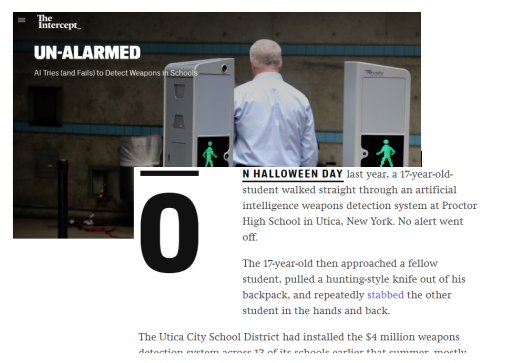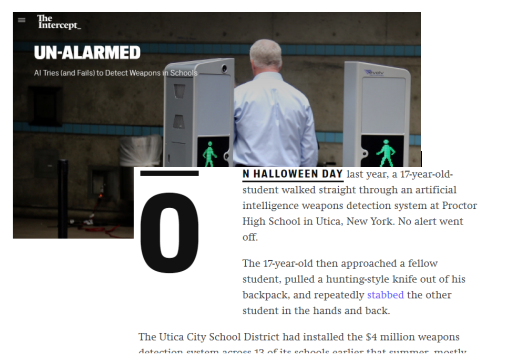3 min read
Reality Check: Gun Detection Technology and (Lack of) Response Preparedness
![]() Theseus Team
:
Jul 18, 2023 4:39:30 PM
Theseus Team
:
Jul 18, 2023 4:39:30 PM

 Let's have an open conversation about a sensitive topic...preventing the presence of guns in vulnerable places such as schools, concerts, sports events, and hospitals.
Let's have an open conversation about a sensitive topic...preventing the presence of guns in vulnerable places such as schools, concerts, sports events, and hospitals.
If you're anything like our Theseus team, you've likely noticed an increase in advertisements for new and improved gun detection technologies, boasting about their new AI-enabled capabilities and other exclusive solutions. As security professionals, we are constantly bombarded with these types of ads, websites, and messages on a daily basis. However, we truly believe in the power of properly applied technology to overcome our greatest safety and security challenges.
And then you see disheartening articles like this about failures of gun and other weapons detection solutions:
Above is a glimpse of the very turbulent state of the security and safety industry when it comes to gun detection technology.
First, let's take a step back and think about why gun detection technology is being deployed into schools, churches, and venues like concerts or sports events.
In recent years, society has faced an alarming rise in gun-related incidents in traditionally safe spaces like schools, churches, and other venues known as soft targets. The urgency to enhance security and protect our communities has led to the adoption of advanced solutions. Among these, gun detection technology is rapidly becoming a mainstay due to its potential to mitigate the devastating impact of such incidents.
Gun detection technology works by identifying firearms through visual cues or other proprietary methods. Some systems employ AI algorithms to scan surveillance footage for firearms, offering real-time threat detection. These systems don't just react to a crisis - they provide the potential to preemptively detect threats and alert authorities.
The deployment of these technologies in soft targets offers several critical benefits. First, it increases reaction times dramatically. In a scenario where every second matters, early detection can enable rapid response and potentially save lives. Secondly, it adds an essential layer of protection without necessitating a visible, intimidating security presence, which can disrupt the inviting atmosphere of these community-centric locations.
Critics express valid concerns about privacy and the risk of false positives, but ongoing refinements are making the technology more reliable and less intrusive. The ability to thwart a potential tragedy outweighs many of these concerns.
While no technology can completely eliminate the threat of gun violence, gun detection systems can significantly contribute to soft target security. They represent a proactive step towards safeguarding our schools, churches, event venues, and other cherished spaces. As these technologies continue to improve and become more widely deployed, we can hope for a safer future for our communities.
BUT...
Is detection of a gun the ultimate solution to the problem? It's not as straightforward as it seems. There are valid concerns regarding false alerts and the potential impact on individuals in the vicinity. What if a lockdown is initiated and hundreds or even thousands of people have to be evacuated? Moreover, what if the gun is concealed in a bag and only revealed later in the day, away from any AI-enabled camera in the hallways or cafeteria or detection device at the entrance?
Additionally, what if a positive detection does occur? Will there be an armed school security resource officer present at the detection device area to immediately neutralize the threat? Or will this responsibility fall upon an unarmed security guard or school staff member assigned to the entrance? And what if there are multiple scanning aisles but an insufficient number of guards, officers, or staff to take appropriate action?
As you can see, there are numerous "what ifs" to consider.
So, what should be done?
It is imperative to conduct a comprehensive evaluation of emergency and security procedures before implementing any technology solutions. Without a well-defined detection and response plan, technology can be easily misapplied, resulting in wasted resources and potentially exacerbating existing problems.
Our expert recommendation is to perform a security risk assessment under the guidance of a professional security consultant. Evaluate the current environmental and physical conditions at your facility, and then implement appropriate technologies based on the consultant's advice and the plan and procedures tailored to your organization.
Our team can assist you every step of the way, from conducting the risk assessment to evaluating technology options and implementing the final solution. Reach out to Theseus Professional Services for a thorough site evaluation and a solution design. We are here to support you. Lets continue the open conversation: info@theseuspro.com
FREE: Physical SECURITY RISK ASSESSMENT CONSIDERATIONS GUIDE
We understand the challenges that security professionals face in securing their facilities and creating a safe environment within their budget. We also recognize the difficulty in finding the right resources and expert advice to achieve this mission.
That's why we're excited to announce the release of our considerations guide, designed specifically to help security professionals conduct their own in-house security risk assessment.
This comprehensive guide aims to assist you in identifying any missing or inadequate physical security measures that may compromise the safety and security of your assets, people, property, and critical business functions. While we highly recommend consulting with a third-party expert like Theseus Professional Services in certain cases, this guide will empower you to take a proactive approach to assess and address security risks within your organization.
The findings of a security risk assessment play a vital role in measuring and communicating the level of risk to your organization. By following the guidelines outlined in this guide, you can enhance the overall security of your facility while staying within your budget.
We believe that knowledge is power, and we're committed to providing you with valuable resources to help you achieve your security goals. Download our considerations guide today and take control of your facility's security.
- Process Evaluation
- Threats
- Vulnerability Assessment Highlights
- Electronic Security Systems Considerations
- Site Considerations
- Building Entrances and Exits
- Common Functional Areas
- Building Envelope
- Utilities and Building Services
- Building Systems





